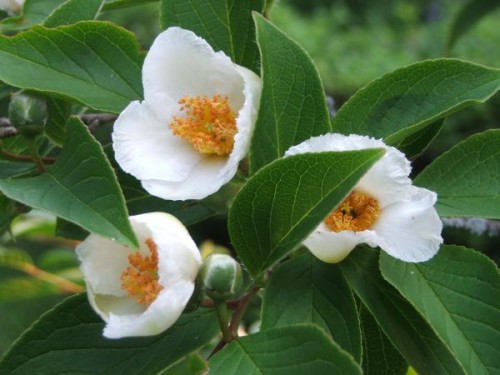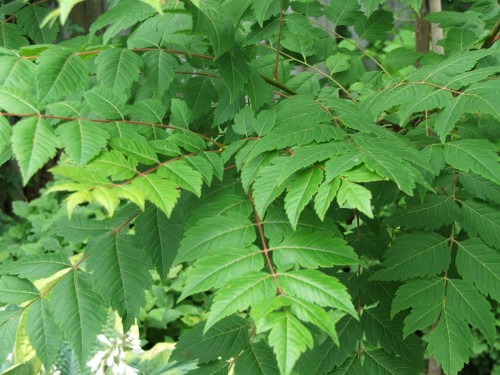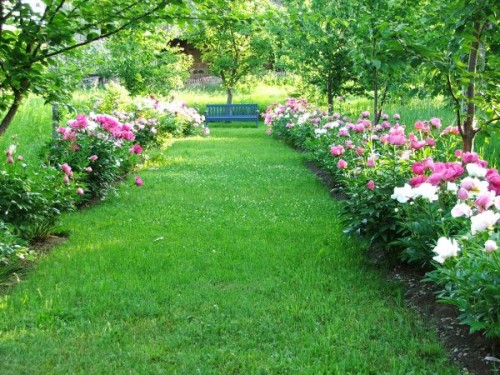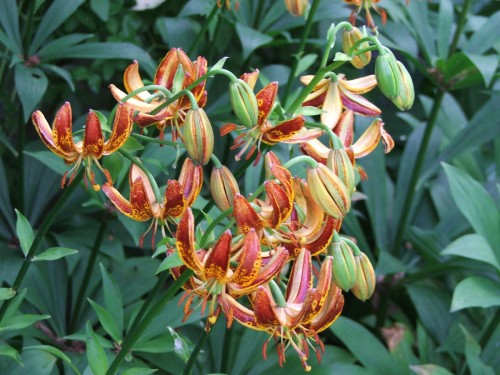Herbert Butterfield’s essay (The Whig Interpretation of History) was an attack on liberal triumphalism [i.e., the ‘Whig interpretation’]…Whig history purveyed a concept of progress as the central theme of English history…It has become common among historians to speak of ‘whig history’ for any subjection of history to what is essentially a teleological view of the historical process. ~ John Burrow, A History of Histories
This morning, I almost dug up the dead golden-foliaged hoptree, Ptelea trifoliata ‘Aurea’. It is dead, I know; dead, gone, finished, kaput. There was no rhyme or reason for its dying. It is on the Front Lawn, protected from all of winter’s hazardous winds, the books say it is hardy (to Zone 3 according to an ancient Lost Horizons catalogue; to Zone 5 if we are to believe the heavyweight RHS Encyclopaedia), it flourished exquisitely last year, it is surrounded by other apparently healthy young trees that have no right to be here at all, and its sibling – though not golden-leaved – survives and grows, little by little each year, in the Maze where it is exposed to all the miseries that winter can manufacture.
It is this caprice that would drive gardeners to a condominium with air-conditioning and a concierge. It is this same caprice that teaches them to be stubborn, to understand that gardening sometimes appears to be an obstacle course, that sloughs of despond, hills of difficulty, doubting castles and mountains of error, are all there to be avoided or negotiated so that on this very same morning as I weed in Charlie’s Place at the entrance to the driveway, I am tempted to an uncorrupted happiness by the intense, sensual fragrance of Daphne alpina at my shoulder.
The loss of the hoptree is not just the loss of a golden exclamation point, but the loss of fragrance, too. It has, in spite of an ungenerous occasional name–tastes do vary–of Stinking Ash, small yellow flowers that make it “probably the most fragrant of any hardy tree” (Hillier). It doesn’t do anything very exciting in the fall, so it violates the late Henry Landis’s criteria for selecting any tree for the garden: good bark, good foliage, good fall colour; flowers are an unnecessary bonus.
Trees That Do Well Here
What makes the loss of the ptelea particularly surprising is that a number of other small trees thought to be more fragile came through with flying colours. Fraxinus ornus, the Manna Ash from southern Europe, with some shelter from spruce trees on the west side of the Western Triangle, lost not an inch at the top, though it seems to have lost a lower twig or two to deer. It is unlikely, given its provenance, the fact that it is a member of the olive family and its May flowering time, that we shall ever see the “showy, creamy white flowers.” Never mind, says Hugh Johnson (The International Book of Trees), the flowers “are only half the story. The whole tree is so voluptuous in glossy leafage that…it stands out in staid parkland like the velvet-framed bosoms of Nell Gwynn and her contemporaries on ancestral dining-room walls.” Even at my age, that’s a cheery thought.
Three other trees are worth a mention. I first saw Aesculus pavia, the Red Buckeye, flowering in the Leonard Buck garden in New Jersey almost twenty years ago, and have longed ever since to be able to grow it. It is a native of the southern United States, a small tree eventually to about 6m, with deep crimson flowers in typical horse-chestnut racemes in June. The buckeyes, both the Ohio and the Yellow, have thrived here, but pavia has been a struggle even though it has the protection of the north fence in the Nursery Garden. This spring it has grown forcefully for the first time, and even though it is less than 2m high, its foliage is striking. The Ohio and Yellow buckeyes flowered well this year, but our Horse-chestnut had not a single flower.
Yet the past winter cannot have been harsh. I am permitted to be definitive on that because Stewartia pseudo-camellia, a tree that meets all of Henry Landis’s criteria, is also about to reveal the bonus.
I shall conceal my jubilation; no hubris is punished so swiftly as the horticultural version. This is the Japanese stewartia (there is a mouth-watering Korean version), said to be hardy to Zone 5, but the only local garden where I have seen it growing well is Amy Stewart’s–the tree isn’t named for her, though it might well be–in Caledon East, some hundreds of feet lower down. Last year the heat of April and early May brought along the buds just in time for them to be wiped out by the frosts and high winds of May 8th/9th. I promise to be good.Finally, a Chinese tree, the Golden Rain Tree, Koelreuteria paniculata.
It should not be confused with the Golden Chain Tree, Laburnum something-or-other; there are quite a few species and cultivars. Koelreuteria is easily grown from seed, the seed coming, in this case, from a Burlington friend who found the tree’s rapidity of growth when happy, and its plethora of flowers, too unrefined for his garden. Here, where there is more space, it is a welcome immigrant, but it has visited before and not stayed long. It lost an inch or two at the top, but has resumed vigorous growth, so I am hopeful, if not optimistic, for its future. It likes dry, sunny conditions, something we can offer it, but I read that it is susceptible to coral-rot fungus, which sounds horrible.I am going now to check on the Northern Catalpa that we planted to replace the ancient Manitoba maple that I wrote about last year. While I am doing that, I’ll take a look at the ptelea, just in case.
* * *
Time and the Garden
One of my spring books has been John Burrow’s A History of Histories (2007). It is a survey of writing by historians from pre-Grecian times up to Eamon Duffy’s The Voices of Morebath
(2001). Burrow’s central enquiry is, How did earlier historians view the past and how did they write about it? The book is eloquent, witty, texturally dense, so much so that the brilliant passages I determine to retain on Thursday evening have slipped through the sieve of my mind by Friday morning. Never mind. Next time I need to know about Herodotus or Vico or Ranke, I shall know where to turn.
Just as when I go to concerts I think about the garden (‘We need more adagio passages’), so it has been difficult for me to read A History of Histories without occasionally asking myself how the text relates to gardens. Gardens are the most history-shaped of all art forms. It may take several years to put up a building, but that is because of the size or the technical issues of the project; if the building could be put up faster, everyone would be pleased.
But time is the essence of a garden, both within a year as the garden passes through its seasons, and from year to year as plantings multiply or recede, as shrubs expand or shrink, as trees grow slowly into their mature shapes. There is no right moment when the garden will be complete, no Celestial City to signify arrival; the garden is always coming from somewhere, going on to somewhere else, but it is a garden now, at this very moment, and we take our pleasure from the process of growth and change. Just as we are, in our personal lives, the integral of our experiences–our ‘history’–so gardens are the slow and irregular accretions of past decisions. There is no destination for a garden. Gardening is inherently anti-teleological.
Among the visitors on our first Open Garden day this spring was a woman who lives most of the time in the Barbados but who also has a house in Owen Sound where she plans to make a garden. She had read about Essays on Gardening in a Cold Climate and about our garden on this very website and she has her own gardening blog, Green Theatre, where you can see, if you should so wish, some of the photos she took at that early moment in the gardening season. (It is quite astonishing for us to look at them and remember how excited we were at such a minimal canvas.)
Deborah–for that is her name–surprised me by stating, rather than asking, “You must have had a plan,” to which I could only reply shamefacedly, “Well, not really, at least…” “At least” meant two things. In the first place, there never was, never has been, any clear notion of where this garden was ultimately headed, no sense of an unwavering direction, no belief that anything is essential. Anything that had been achieved had come about through a series of ad hoc piecemeal design engineering responses to problems that suddenly or slowly made themselves manifest.
But, secondly, in the 1990s we finally drew a plan of how the garden then was, and a series of plans of what the garden had looked like at various times over the preceding thirty years. Those plans both revealed to us the follies of the past and suggested changes that might compensate (or at least cover up) the flaws; and they also suggested lines of future directions.
The failure to plan means the garden is filled with design aberrations, of curves that do not trace out the Hogarthian Line of Beauty, of straight lines that wander in order to accommodate some earlier transgression or afterthought. We have imposed little on the natural shapes and contours of the landscape, and the decreasing formality and maintenance as you move away from the house links the garden integrally with the surrounding countryside. Perfection is intolerable, inhuman. We stumble forward, with the happy feeling that we are making a garden outside the Whig tradition. Three cheers for Butterfield!
* * *
What Blooms Here in Mid- to Late June
Middle, late June is one of the most exciting moments. If the weather cooperates, the Peony Hedges will be in flower at the same time as the Martagon lilies.
The Beauty Bushes (Kolkwitzia amabilis) will face the row of Japanese Lilac trees along opposite sides of the driveway. Abelia mosanensis in the Nursery Garden is even now covered with dark pink buds that will open to light pink flowers with a fragrance “better than a lilac”. Immediately to its north Calycanthus floridus is producing its unusual maroon flowers with a fragrance, one writer says, of “strawberry-pineapple” (I have been on my knees, sniffing, without detecting either); and to its north the enormous Rosa moyesii will be sprinkled with small, bright rose flowers. The exotic Lilium hansonii–exotic for its colouring but also for its provenance: in the wild it is said to be found only on the small island off the coast of Korea–is poised to flower in the Barnyard Beds.
The dashing ‘Beauty of Livermore’ oriental poppy has begun its display beneath the silvery foliage of Pyrus salicifolia, and Actinidia kolomikta (the Cape Gooseberry) is beginning its pink-and-white thing, while its small white flowers, gone by the 19th, are perfuming the Barnyard entrance with lemon. Various herbaceous clematis will surprise you with their forms and colours. Pinks are in full cry; be sure not to overlook their roadside flowering to both the east and the west of the house. But as you know, it’s not just about the plants.The next open garden at Lilactree Farm will be September 18th. Visitors at other times are welcome by appointment only.









Recent Comments